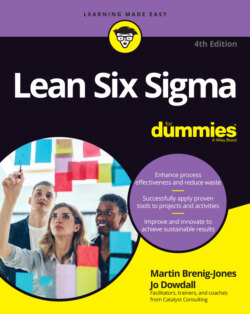Читать книгу Lean Six Sigma For Dummies - Martin Brenig-Jones - Страница 13
Bringing on the basics of Lean
ОглавлениеFigure 1-1 shows the Toyota Production System, highlighting various tools and Japanese Lean thinking terms that we use throughout this book. In this chapter we provide some brief descriptions to introduce the Lean basics and the TPS.
© Martin Brenig-Jones and Jo Dowdall
FIGURE 1-1: The TPS house.
Toyota’s Taiichi Ohno describes the TPS approach very effectively:
All we are doing is looking at a timeline from the moment the customer gives us an order to the point when we collect the cash. And we are reducing that timeline by removing the non-value adding wastes.
The TPS approach really is about understanding how the work gets done, finding ways of doing it better, smoother and faster, and closing the time gap between the start and end points of our processes. And it applies to any process. Whether you’re working in the public or private sector, in service, transactional or manufacturing processes really doesn’t matter.
Think about your own processes for a moment. Do you feel that some unnecessary steps or activities seem to waste time and effort?
We must point out, however, that simply adopting the tools and techniques of the TPS isn’t enough to sustain improvement and embed the principles and thinking into your organization. Toyota chairperson Fujio Cho provides a clue as to what’s also needed:
The key to the Toyota way is not any of the individual elements but all the elements together as a system. It must be practiced every day in a very consistent manner — not in spurts. We place the highest value on taking action and implementation. By improvement based on action, one can rise to the higher level of practice and knowledge.
Perhaps this is why Toyota didn’t mind sharing the secrets of their success. It might be easy to replicate certain practices and adopt certain concepts, but it is not easy to replicate a true culture of Continuous Improvement.
